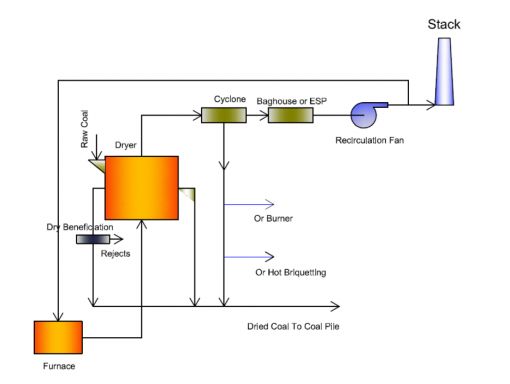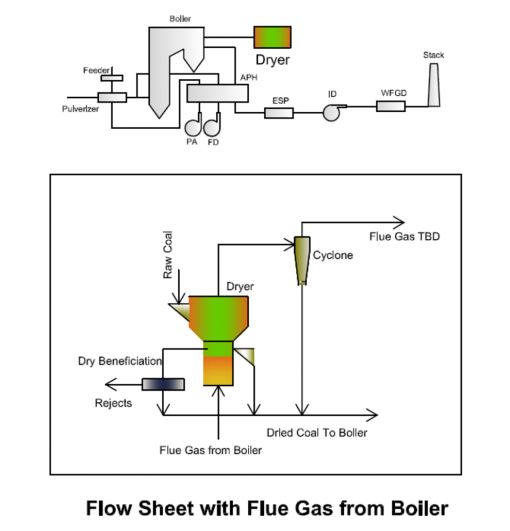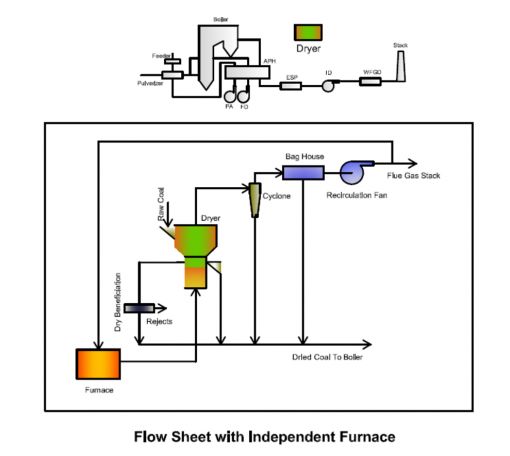Delta also extends the application of high temp fluidized bed dryer to the drying, heating and calcining of non-heat-sensitive materials in the form of lump, grain and powder in inorganic salts, fertilizers, minerals industries to replace existing fluidized bed dryer / calciner with immersed steam heat exchangers, rotary dryer / calciner, rotary dryer / calciner with steam tubes.
Delta also provides low and high temp large scale fluidized bed dryer / reactor / calciner.
Two Major types of drying system for coal drying
A, FGFB Drying system
FGFB Drying system stands for fluidized bed dryer with flue gas as drying heat source.
History of fluidized bed dryer for coal drying
Fluidized bed dryer (FGFB) for coal drying began in 1955, and it has been becoming the first choice for coal drying for coal preparation plants subsequently.
There were 6 units of fluidized bed dryers, 6 units of rotary dryers and 64 units of vibrating fluidized bed dryers in operation in coal preparation plants in US in 1958.
There were over 170 units of fluidized bed dryers in operation in coal preparation plants in US in 1980's.
Some fluidized bed dryers are still in operation today after 40 years installation.
Low temp FGFB drying system
Low temp FGFB dryer utilizes low temp flue gas (150C -400C) from boiler systems in power plants or coking oven furnace in coking plants as heating source for drying process, which possesses significant effect in energy saving and greenhouse gas reduction.
High temp FGFB drying system
High temp FGFB dryer has been developed based on conventional low temp (650 C and below ) to utilize high temp flue gas (700 C to 1000 C ).
The inlet flue gas temp was only about 450 C in the original design in the early stage, and it was gradually increased with the increase of production. The highest inlet flue gas was reached 700 C in operation nowadays. Delta has developed air distribution with independent Intellectual Property Rights which made it possible to increase inlet flue gas to 1000 C.
Advantages of high temp FGFB dryer:
- Smaller equipment size; lower capital investment; lower energy consumption due to higher inlet flue gas temp;
- Large capacity, up to 500t/h water evaporation;
- Can dry coarse material, up to 50 mm;
- For lignite coal with high ash content, drying and dry separating (to remove ash) can be integarted;
- Drying system can be designed as positive pressure which made it possible to achieve <3% of system oxygen concentration without risk for dust explosion;
- Fine coal can be separated from coarse coal;
- Exhaust temp can be very low, close to its dew point with maximum degree of energy utilization.
Coal dust explosion
Explosion Severity for coal dust is belonged to ST Class 1 (weak to moderately explosible). Coal dust explosion should be solved first in coal drying.
Triangles for Dust Explosion: 1), Ignition sources: 2), Dust concentration ( 60g/m3 for hard coal and 30g/m3 for lignite coal); 3), Oxygen concentration (12% for hard coal and 12.5% for lignite coal).
Dust explosion can be eliminated completely if any one side of triangle is removed. As the diversity of ignition sources and unpredictability of dust concentration, lowing oxygen concentration of drying system is relatively easy to implement. In fact, lowing the oxygen concentration of drying system has be widely employed in industries to prevent dust explosions.
B, SFB Drying system
SFB Drying system stands for drying system combined of fluidized bed dryer with immersed heat exchanger and superheated steam drying (SSD) system (same as RWE's WTA technology)
Fluidized bed dryer with immersed heat exchanger
Heat energy required in conventional fluidized bed dryer was supplied by fluidization media, i.e, fluidization gas has to meet two requirements simultaneously:
(1), Dynamic conditions required by materials being dried;
(2), Heat energy needed by materials being dried;
For lower inlet fluidization gas temp, the flow rate of fludization gas required is higher, the energy loss from exhaust is higher, which leads to lower drying efficiency, large equipment size and higher capital investment.
Fluidized bed dryer with immersed steam heat exchanger was developed based on conventional fluidized bed dryer: steam heat exchanger is built inside drying chamber and is immersed completely with fluidized materials, the heat energy required by materials being dried is supplied by steam heat exchanger mostly. Main function of fluidization gas is to meet the dynamic condition required by materials being dried. Therefore, dynamic condition and heat energy are independent. flow rate of fluidization gas can be reduced to minimum degree, resulting in smaller equipment size, lower capital investment and energy consumption.
It is ideal drying process for lignite coal pre-drying in power plants (coking coal drying in coking plants) as it needs steam:
- Low pressure can be extracted from turbine;
- Plant efficiency can be improved as LP steam for drying process is low grade energy.
Superheated steam drying (SSD) system
SUPERHEATED STEAM DRYING (SSD) utilizes superheated steam as drying media instead of hot air or combustion/flue gases in a conventional dryer. Its main benefit: Closed-loop system reduces the energy; Evaporated moisture can be recovered; High heat transfer – high drying rate, reduction in the equipment size and capital cost; No oxidation can eliminate fire and explosion hazards; Elimination of environmental pollution; Valuable volatile organic compounds could be recovered
Drying systems and applications
Delta has developed the following coal drying and briquetting systems for the following applications:
- High Temp FGFB Drying and Briquetting Process;
- Low Temp FGFB Drying and Briquetting Process;
- Fluidized Bed Dryer with Immersed Steam Heat Exchanger;
- Fine Coal Hot Briquetting Process;
- Modified LFC Process;
- Modified SCOPE21 Process;
- Oil Extracting from oil shale and oil sand;
Other Applications
High temp fluidized bed drying technology can also be used for the drying, heating and calcining of non-heat-sensitive materials in the form of (or can be converted to by mixing process ) lump, grains and powder; flue gas temperature can be up to 1400 C for non-explosive material drying, heating and calcining; therefore it is possible to replace rotary dryer / calciner, steam tube rotary dyer / calciner, fluidized bed dryer / calciner with immersed steam heat exchangers:
Building material: sands, quartz sand, frac sand, etc;
Fertilizers: KCl, KSO4, etc;
Inorganic salts: Compounds of sodium, calcium, magnesium, manganese, nickel, lithium, etc;
Non-Metallic and Metallic Ore: Cu concentration, kaolin/ clays, etc;
Wastes: Municipal and industrial sludge, industrial solid wastes, etc;
Coal Mines
Delta provides the following lignite coal drying technologies for coal mines:
- High Temp FGFB Drying, Dry Beneficiation & Briquetting Process
- Modified LFC Process
- Fine Coal Hot Briquetting Process
Process Flow Chart

Major issues with dried lignite coal:
- Spontaneous combustion
- Dustiness
Mechanism of spontaneous combustion of lignite coal
Lignite coal has a large surface area and therefore has a strong ability to absorb oxygen due to its porous structure;
When lignite coal contacting with air, oxygen physisorption of coal occurs first, and physisorption heat is released;
Chemical absorption and chemical reaction happens and chemical reaction and chemical adsorption heat are released afterwards;
It will cause self-heating if heat produced cannot be carried away immediately and coal temperature rises constantly with heat buildup inside coal;
Coal temperature rising causes the oxidation reaction more intensive; intensive reaction would release more heat; and speed of coal temperature rising accelerates further and vicious circle accelerates, spontaneous combustion occurs when coal temperature reaches its ignition temperature.
Solutions?
Contact with Delta for more details.
Power Plants
Delta provides the following lignite coal pre-drying technologies for power plants: (1) for existing lignite coal fired power plants to cut its coal consumption; (2) for new lignite coal fired power plants to cut its capital cost and coal consumption; (3) for existing hard coal fired power plants to switch to lignite coal fully to cut its operation cost:
- High Temp Flue Gas Fluidized Bed Drying & Dry Beneficiation Process (High temp flue gas from existing boiler or independent furnace)
- Low Temp Flue Gas Fluidized Bed Drying & Dry Beneficiation Process (Low temp flue gas from existing boiler after APH and before ESP)
- Fluidized Bed Dryer with Immersed Steam Heat Exchanger (LP steam from turbine
Features:
- Dryer with flue gas can dry raw coal 0-50 mm, so it can be fit for CFB boiler and PC boiler;
- Dyer with LP steam can only dry raw coal 0-3 mm, so it can only be fit for PC boiler;
- Dry Beneficiation system is optional;
- Low temp flue gas is more suitable for LLT ESP/Colder Side ESP with WFGD
Process Flow Chart

Coking Plants
Delta provides the following drying technologies for coking process:
- Low Temp FGFB Bed Drying Process (Utilization of waste energy from coking oven flue gas )
- High Temp FGFB Drying & Briquetting Process Process (High temp flue gas from independent furnace)
- Low Temp & High Temp Combined FGFB Drying & Briquetting Process
- Modified SCOPE21 Process
- Fine Coal Hot Briquetting Process
Process Flow Chart














